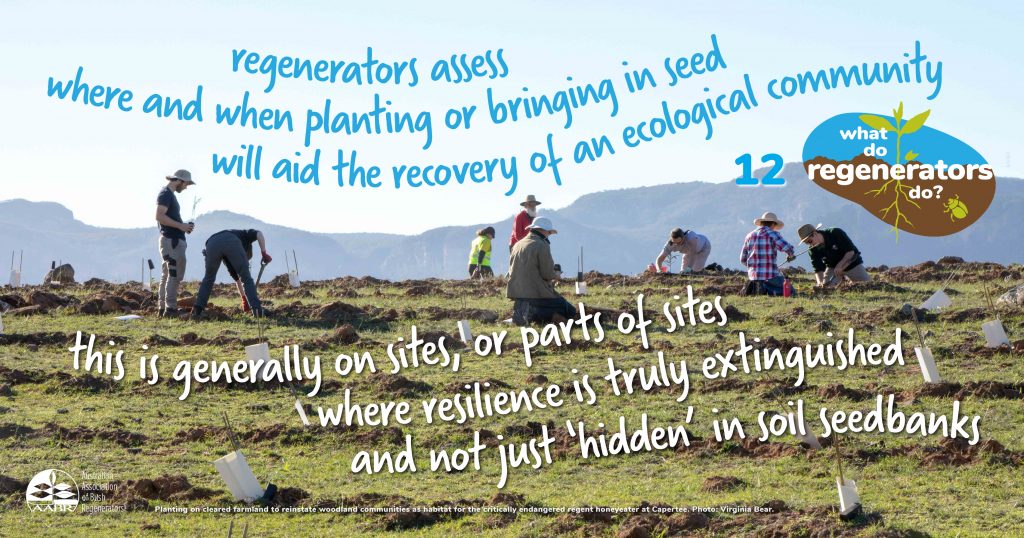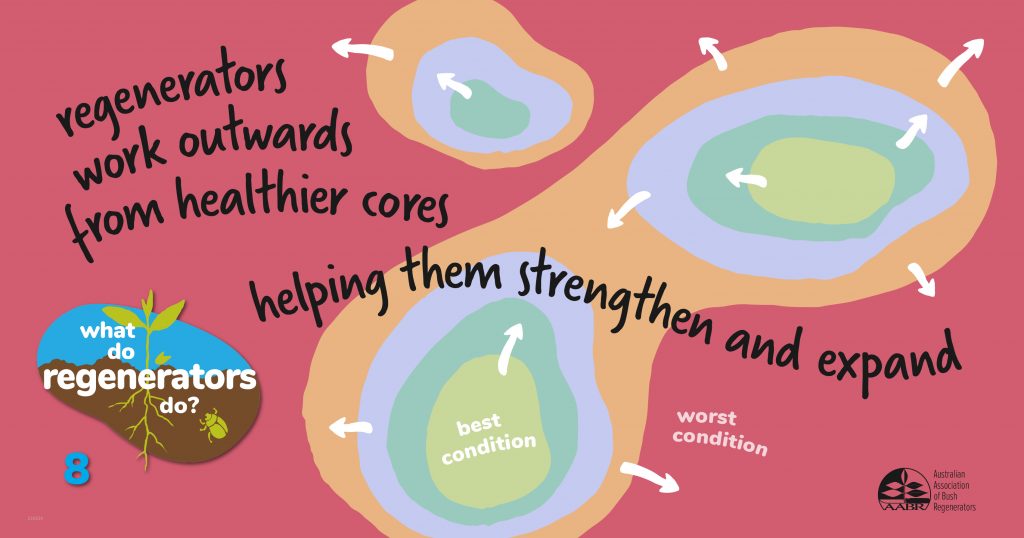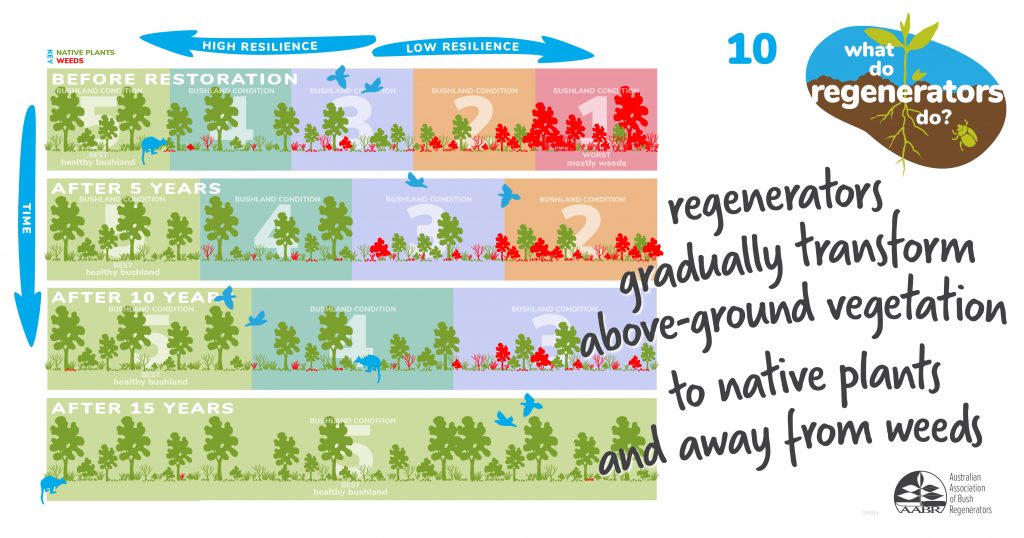Planting in Bushland?
… but what about natural regeneration. It’s the key to restoring and managing our bush.
Download Planting in Bushland?
Grow me Instead: A guide for gardeners in the greater Sydney district.
Many of the plants that have become invasive have come from private gardens. By selecting plants carefully at your local nursery or garden centre or from the alternative plants suggested here you can achieve an environmentally ‘friendly’ garden and in so doing, help preserve indigenous species and habitat for native fauna.
DECIDING ON THE BEST TREATMENTS
Natural regeneration is the goal of your project, but which approach do you use to get there?
Where resilience exists, it is most effective to choose either natural regeneration or assisted natural regeneration methods (which are designed to trigger germination or resprouting)
Where dormant seed or buds no longer exists, you need to use reconstruction treatments (which are designed to replace the missing bits and get regeneration moving again)
It might be useful in some intermediate cases to use all approaches. But it is helpful to keep regeneration and reconstruction approaches separate in your head for a while because we usually are too hasty in assuming reconstruction is needed.
-
REGENERATION APPROACHES
(a) FAIRLY GOOD AREAS (ie. with some trees, shrubs or evidence of ground covers still present)
- Do not plant – as natural regeneration is certain
- Remove the problems that are causing the degradation in the first place – ie. grazing or weeds,
- Apart from a decreasing amount of follow up weed management, further intervention is unlikely to be necessary, although regeneration may be slow in dry areas and without some trigger such as fire.
(b) FAIRLY POOR AREAS (ie. with little or no natives left)
If the area is in poor condition, particularly if road drains are involved, more interventions will be needed to address scouring or nutrient enrichment. Also, weed clearing in highly weed infested sites is very exacting because of the amount of time needed to keep revisiting the sites and removing new flushes (often different species) that have been triggered to germinated because of your treatment. If you are not prepared to commit yourself to unexpected amounts of work for a while, don’t even clear a poor condition area in the first place Otherwise clearing weed can actually make the problem worse. Also, if there is native germination, you must select your weeding techniques to avoid damaging the natives.
A good approach is to just bite off a small area and run a trial. This way you will not only get some idea of the weeds, but you can try a couple of other triggers to see if there is any buried native seed bank.
Regeneration treatments to trial in small areas for highly degraded bush
Prioritisation
Areas of higher native regeneration potential (resilience) can be very useful starting points in a gradual restoration program as they are a source of expansion. In rainforest sites, even a dead tree in an open paddock can be a useful starting point for regeneration – but similarly, just one weed climber on a healthy tree in a healthy remnant can be a starting point for degradation and may be the most urgent place to start work.
This suggests that priorities for work will depend on how quickly a site can change with or without treatment. If leaving it or treating it (whether the area is in really good or really poor condition) will not produce much change, it might be more productive to give it a lower priority. But if treating it will produce considerable change (because it otherwise may rapidly degrade or because its recovery will strategically improve recovery prospects in other areas) it may be a higher priority area.
Most change will occur in a plant community at the edge between the core areas or reasonably good condition and the more degraded areas. Starting here will ensure that desirable species are available to colonise outwards into the poorer areas and can better compete with weeds. If the cores themselves are relatively intact, starting work in these areas is unlikely to produce the most rapid change. But if the cores are themselves degraded, they are likely to produce the most rapid and potentially useful changes and are therefore the best places to commence work.
-
RECONSTRUCTION
Reconstruction is often assumed to be the same as planting or “landscaping”. But the approaches used and the techniques in many cases, are quite different.
In reconstructing a plant community from scratch, we have to have an ecological model and goals.
A model (reference community) The model is usually the pre-existing plant community, unless conditions have changed so much you have to use a different local plant community (perhaps better adapted to permanently changed site conditions) as your model.
Goals The overall goal is to achieve a community capable of perpetuating itself. Therefore, you need specific objectives that ensure that certain things happen such as the species that would normally store in the seed bank get a chance to build up a seed bank before being shaded out by species that can resprout.
Objectives may involve numbers of species and spacings so that both sets of species get a chance.
Your community’s plants will require insects, birds and other animals for pollination or dispersal of seed. So you need to devise objectives that ensure their habitat needs are met or the system will not reproduce.
SUBSTRATE
The capacity for restoration will depend on whether the soil’s fertility and hydrology is within the range of conditions required by the pre-existing community.
- Check any drainage problems. Drainage impeded areas will require certain plants. Or perhaps you can correct the drainage problems or minimise the area affected.
- Check the pH with a field kit (available at any good plant shop or rural suppliers) and compare it with local bushland. Too high an elevation may be a problem for some species. If too low, the site might not be sufficiently fertile and may need help.
- Check the salinity by signs of salt or dieback.
If any of these measures are outside the range for your bushland type, think again. Fix it – or try another community as your model.
Site preparation and reintroduction techniques
Excellent guidelines for site preparation and introduction techniques (direct seeding or planting) for sclerophyll and rainforest areas already exist and can be searched for on the web. Genetic guidelines are most important to ensure your community develops appropriate genetic diversity.
But it is essential to understand that your reconstruction will be ultimately only as good as the seed bank and rootstock bank you build up. If you allow weed to develop a seed bank or a rootstock bank, this will contaminate your community in the longer term.
If you wish to aim for low or nil levels of weed contamination, work up your site for some months if not a year in advance with some repeated disturbance followed by weed killing (choose your weapon to match the scale of the job). If you see native ground covers coming up as a result of this disturbance, consider selectively weeding to favour them as they may provide you with a weed-resistant reconstruction base.
Follow up weeding and consolidation
Your job is not over when you have finished reintroductions. Treat your site like it is a regeneration site from now on. Keep weed out of it. Ensure the species you want to build up a seed bank get to flower and fruit before being shaded out. Cull competitors if not. If you are working in a rainforest area, you may wish to cull competitive earlier phase species if later phase species are ready to emerge into the canopy.
If you have a woodland or forest in the making, you could use fire to check how healthy the seed bank is. But hold back from using fire until the trees are old enough to survive fire by resprouting and after the shrubs that won’t survive a fire have fruited at least three times. About 13-15 years after planting might be a good guide.





Leave A Comment